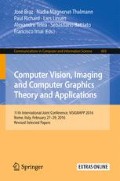Abstract
Applying flow maps in large datasets involves dealing with the reduction of visual cluttering. Nowadays, a technique known as edge bundling, which is geometric in nature, is often applied to reduce visual clutter and create meaningful traces that highlight the main streams of flow. This article presents an alternative approach of edge bundling for generating flow maps. Our approach uses a swarm-based system to reduce visual clutter, bundling edges in an organic fashion and improving clarity. The method takes into account the properties of data, edges and nodes, to bundle edges in a meaningful way while tracing lines that do not interfere visually with the nodes. Additionally, the Dorling cartograms technique is applied to reduce overlapping of graphical elements that render locations in geographic space. The method is demonstrated with application in the analysis of the US migration flow and transportation of products among warehouses and supermarkets of a major retail company in Portugal.
Access this chapter
Tax calculation will be finalised at checkout
Purchases are for personal use only
References
Reynolds, C.W.: Steering behaviors for autonomous characters. In: Game Developers Conference, vol. 1999, pp. 763–782 (1999)
Dorling, D.: Area Cartograms: Their Use and Creation. Concepts and Techniques in Modern Geography, vol. 59. University of East Anglia: Environmental Publications (1996)
Tufte, E.R.: The Visual Display of Quantitative Information, vol. 2. Graphics Press, Cheshire (1983)
Phan, D., Xiao, L., Yeh, R.B., Hanrahan, P., Winograd, T.: Flow map layout. In: Stasko, J.T., Ward, M.O. (eds.) IEEE Symposium on Information Visualization (InfoVis 2005), 23–25 October 2005, MN, USA, p. 29. IEEE Computer Society, Minneapolis (2005)
Holten, D.: Hierarchical edge bundles: visualization of adjacency relations in hierarchical data. IEEE Trans. Vis. Comput. Graph. 12, 741–748 (2006)
Holten, D., van Wijk, J.J.: Force-directed edge bundling for graph visualization. Comput. Graph. Forum 28, 983–990 (2009)
Hurter, C., Ersoy, O., Telea, A.: Graph bundling by kernel density estimation. Comput. Graph. Forum 31, 865–874 (2012)
Peysakhovich, V., Hurter, C., Telea, A.: Attribute-driven edge bundling for general graphs with applications in trail analysis. In: 2015 IEEE Pacific Visualization Symposium, PacificVis 2015, Hangzhou, China, 14–17 April 2015, pp. 39–46 (2015)
Di Marzo Serugendo, G., Gleizes, M.P., Karageorgos, A.: Self-organising systems. In: Di Marzo Serugendo, G., Gleizes, M.P., Karageorgos, A. (eds.) Self-Organising Software. Natural Computing Series, pp. 7–32. Springer, Heidelberg (2011). doi:10.1007/978-3-642-17348-6_2
Macgill, J., Openshaw, S.: The use of flocks to drive a geographic analysis machine. In: International Conference on GeoComputation (1998)
Vande Moere, A., Mieusset, K.H., Gross, M.: Visualizing abstract information using motion properties of data-driven infoticles. In: SPIE Proceedings Series, pp. 33–44 (2004)
Moere, A.V.: Time-varying data visualization using information flocking boids. In: Ward, M.O., Munzner, T. (eds.) 10th IEEE Symposium on Information Visualization (InfoVis 2004), 10–12 October 2004, TX, USA, pp. 97–104. IEEE Computer Society, Austin (2004)
Reynolds, C.W.: Flocks, herds and schools: a distributed behavioral model. In: Stone, M.C. (ed.) Proceedings of the 14th Annual Conference on Computer Graphics and Interactive Techniques, SIGGRAPH 1987, pp. 25–34. ACM (1987)
Polisciuc, E., Cruz, P., Amaro, H., Maçãs, C., Carvalho, T., Santos, F., Machado, P.: Arc and swarm-based representations of customer’s flows among supermarkets. In: Proceedings of the 6th International Conference on Information Visualization Theory and Applications, pp. 300–306 (2015)
Maçãs, C., Cruz, P., Amaro, H., Polisciuc, E., Carvalho, T., Santos, F., Machado, P.: Time-series application on big data visualization of consumption in supermarkets. In: Proceedings of the 6th International Conference on Information Visualization Theory and Applications, IVAPP 2015, Berlin, Germany, 11–14 March 2015, pp. 239–246. SciTePress (2015)
Maçãs, C., Cruz, P., Martins, P., Machado, P.: Swarm systems in the visualization of consumption patterns. In: Proceedings of the Twenty-Fourth International Joint Conference on Artificial Intelligence, IJCAI 2015, Buenos Aires, Argentina, 25–31 July 2015, pp. 2466–2472. AAAI Press (2015)
Fruchterman, T.M., Reingold, E.M.: Graph drawing by force-directed placement. Softw. Pract. Exp. 21, 1129–1164 (1991)
Acknowledgements
We would like to thank Catarina Maçãs, Hugo Amaro, Filipe Assunção, Antnio Cruz and Pedro Cruz for their contributions to this work. This project is partially funded by sonae: Sonae Viz – Big Data Visualization for retail, and by Fundação para a Ciência e Tecnologia (FCT), Portugal, under the grant SFRH/BD/ 109745/2015.
Author information
Authors and Affiliations
Corresponding author
Editor information
Editors and Affiliations
Rights and permissions
Copyright information
© 2017 Springer International Publishing AG
About this paper
Cite this paper
Polisciuc, E., Machado, P. (2017). Swarm-Based Edge Bundling Applied to Flow Mapping. In: Braz, J., et al. Computer Vision, Imaging and Computer Graphics Theory and Applications. VISIGRAPP 2016. Communications in Computer and Information Science, vol 693. Springer, Cham. https://doi.org/10.1007/978-3-319-64870-5_15
Download citation
DOI: https://doi.org/10.1007/978-3-319-64870-5_15
Published:
Publisher Name: Springer, Cham
Print ISBN: 978-3-319-64869-9
Online ISBN: 978-3-319-64870-5
eBook Packages: Computer ScienceComputer Science (R0)

